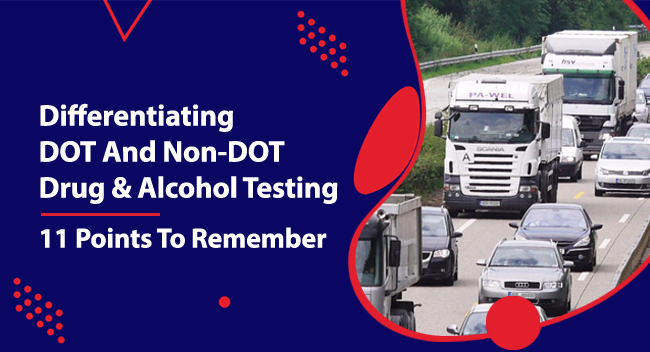People often get confused between the DOT drug and alcohol test and the non-DOT testing. The department of transportation is the authority under which the DOT-regulated drug and alcohol test is carried out.
When we talk about the non-DOT drug and alcohol test, it usually makes room for state-level regulations that ensure that the workplace is drug-free.
These regulations differ from one state to another. Let’s comprehend the basic differences between the two in the following section:
1. What Are Non-DOT Drug Tests?
If you happen to work in an industry that is not regulated by the US department of transportation, you will be tested under the non-DOT drug test category.
There are two parallels that are running together when it comes to drug testing. If you fall under the non-DOT drug category, it can include a much wider range of drug tests that may be used to identify several substances.
A non-DOT drug test can include 7-panel, 10-panel, 12-panel, and even 15-panel testing. There are non-DOT urine drug tests available as well. They offer a little more flexibility when it comes to the entire testing procedure.
As a DOT-regulated company, you will always be required to undergo a DOT drug test. However, you can establish your own drug testing protocol by getting in touch with your third-party administrator.
If you want to conduct your DOT as well as non-DOT Drug & Alcohol testing, they must be done separately. The process of the non-DOT urine test is usually faster than the DOT drug test.
2. What Is A Non-DOT Physical?
A non-DOT examination is carried out in industries that are not regulated by the department of transportation. This is just to find out whether the employee is fit for work or not.
It is a part of their usual work fitness assessment and can be carried out by any third-party administrator as well. The physical assessment of the employee or the potential candidate is going to include their cardiovascular health, body posture, strength and stamina, range of motion, functional movements, manual material handling, stability of their joints, and overall muscle flexibility.
These tests do not include the vision, hearing, or urinalysis of the candidate. There are several companies in the industry that offer pre-employment non-DOT physical examinations. You can get in touch with any of them to understand the procedure further.
3. What Happens At A Non-DOT Physical?
It is very simple to understand. A typical non-DOT physical examination encompasses the following:
- A complete and thorough review of your medical history
- Assessment of your height, body, weight, BMI, and vital signs
- Urine specimen
- Glucose test for diabetes
- Vision testing
- Assessment of the range of motion
- Hernia examination
- Examination of the back muscles
4. How Much Does A Non-DOT Drug Test Cost?
You can get in touch with DOT Compliance Group to know the latest pricing. This is usually the most commonly performed test which is a 5-panel examination.
It is done to identify substances such as marijuana, amphetamine, cocaine, opiates, and PCP.
5. What Happens When You Test Positive On A Non-DOT Drug Test?
The one big thing that is going to differentiate the DOT drug and testing program from the non-DOT drug and testing program is that the latter does not result in any federal prohibitions.
It still does not mean that you should be negligent of your substance or alcohol use. You might still not be considered fit for the job if you test positive for a non-DOT drug test. The employer has the freedom to reject you based on this test result.
6. What Is Included In A Non-DOT Drug Test?
A non-DOT drug test is different from a DOT test. A non-DOT test is for a potential employee or a candidate looking for a job in an industry that is not regulated by the US department of transportation.
A typical non-DOT drug & alcohol testing program identifies the presence of substances such as barbiturates, benzodiazepines, propoxyphene, Quaaludes, methadone, and the like.
It includes a urine test along with a physical examination. In addition to that, it can also include a 7-panel, 10-panel, 12-panel, and also a 15-panel test.
7. Who Needs To Undergo A Non-DOT Drug Testing?
Employees working in the non-DOT regulated industry usually go for this test. These tests are typically dictated by the individual employer and not the department of transportation.
The entire drug-testing program can be as per the rules and regulations and the requirements of the enterprise. Several established companies have their own drug and testing policies that they follow.
8. What’s The Difference Between DOT And Non-DOT Drug Tests?
There are several points of differences between DOT and non-DOT drug tests. A glimpse of them is as follows:
The Testing Samples Taken
In a typical DOT drug test, the sample taken is strictly urine. DOT alcohol tests can make use of saliva or breath as well. A non-DOT test can take different samples such as saliva, hair, urine, breath, and sweat.
Authorization Of The Tests
A non-DOT test can be used for multiple purposes. It can be used by the government and the department of transportation and for the DNA as well. A DOT drug test is not meant for all those purposes.
Testing Certification
The laboratories that conduct the DOT drug test have to be certified by the substance abuse and mental health services administration. The non-DOT labs across the country are certified by the College of American Pathologists and the Clinical Laboratory Improvement Act.
Chain Of Custody Form
A DOT drug test requires a specific chain of custody forms and alcohol testing forms and other formalities and protocols. A non-DOT test is prohibited from using any of these forms.
Drug Testing Policies
Non-DOT employers enjoy more liberty and leniency when it comes to enforcing testing policies. But then they also don’t get any protection offered by the DOT regulations.
It makes sense for non-DOT employers to pay more attention to establishing clearer and more comprehensive policies around their drug and alcohol testing programs.
9. What Happens When Results Come Out Positive?
In the case of a DOT-regulated company or industry, the department of transportation is going to decide what happens next. In the case of a non-DOT employee, the employer is at liberty to take the next step.
10. What Are The Cut-Off Levels For A Non-DOT Drug Testing?
The drug names and their screen cut-off limits are given as follows:
Lab-Based Drug Cut-offs (Urine)
- Amphetamines – 500ng/mL
- Cocaine metabolites – 150 ng/mL
- Marijuana metabolites – 50ng/mL
- MDA-analogues – 500ng/mL
- Opiates – 2000 ng/mL
- 6-Acetylmorphine (6-AM) – 10ng/mL
- Opiates (semi-synthetic) – 300 ng/mL
- Oxycodone – 100 ng/mL
- Phencyclidine (PCP) – 25 ng/mL
Urine Specimen 5-Panel Drug Test
- Amphetamines – 1000 ng/mL
- Cocaine metabolites – 300 ng/mL
- Marijuana metabolites – 50 ng/mL
- Opiates – 2000 ng/mL
- Phencyclidine (PCP) – 25 ng/mL
Urine Specimen 9-Panel
- Amphetamines – 1000 ng/mL
- Cocaine metabolites – 300 ng/mL
- Marijuana metabolites – 50ng/mL
- Opiates – 2000 ng/mL
- Phencyclidine (PCP) – 25 ng/mL
- Barbiturates – 300 ng/mL
- Benzodiazepines – 300 ng/mL
- Methadone – 300 ng/mL
- Propoxyphene – 300 ng/mL
Instant Urine Drug Test
- Amphetamines – 1000 ng/mL
- Methamphetamines – 1000 ng/mL
- Cocaine/metabolite – 300 ng/mL
- THC/metabolite – 50 ng/mL
- Opiates – 2000 ng/mL
- Phencyclidine (PCP) – 25 ng/mL
Oral Fluid Drug Test
- Amphetamine – 150 ng/mL
- Cocaine metabolites – 15ng/mL
- Marijuana – 3 ng/mL
- Methamphetamines – 120 ng/mL
- Opiates – 30 ng/mL
- Oxycodones – 30 ng/mL
- Phencyclidine (PCP) – 3 ng/mL
Hair Drug Test
- Methamphetamines – 500 pg/mg
- MDMA – 500 pg/mg
- Amphetamine – 500 pg/mg
- Cocaine/metabolites – 500 pg/mg
- Benzoylecgonine – 500 pg/mg
- Marijuana metabolite – 1.0 pg/mg
- Opiates (MOR &/OR HYM) – 200 pg/mg
- Opiates (COD &/OR HYC) – 200 pg/mg
- 6‐Acetylmorphine (6‐AM) – 200 pg/mg
- Oxycodone – 200 pg/mg
- Oxymorphone – 200 pg/mg
- Phencyclidine (PCP) – 300 pg/mg
11. What Substances Are Tested In A Non-DOT Drug Testing?
Below are a few substances that are tested in a non-DOT drug test:
- Marijuana
- Cocaine
- Opiates
- PCP
- Methadone
- Propoxyphene
- Quaaludes
- Barbiturates
- Amphetamine
- Benzodiazepines








0 Comments